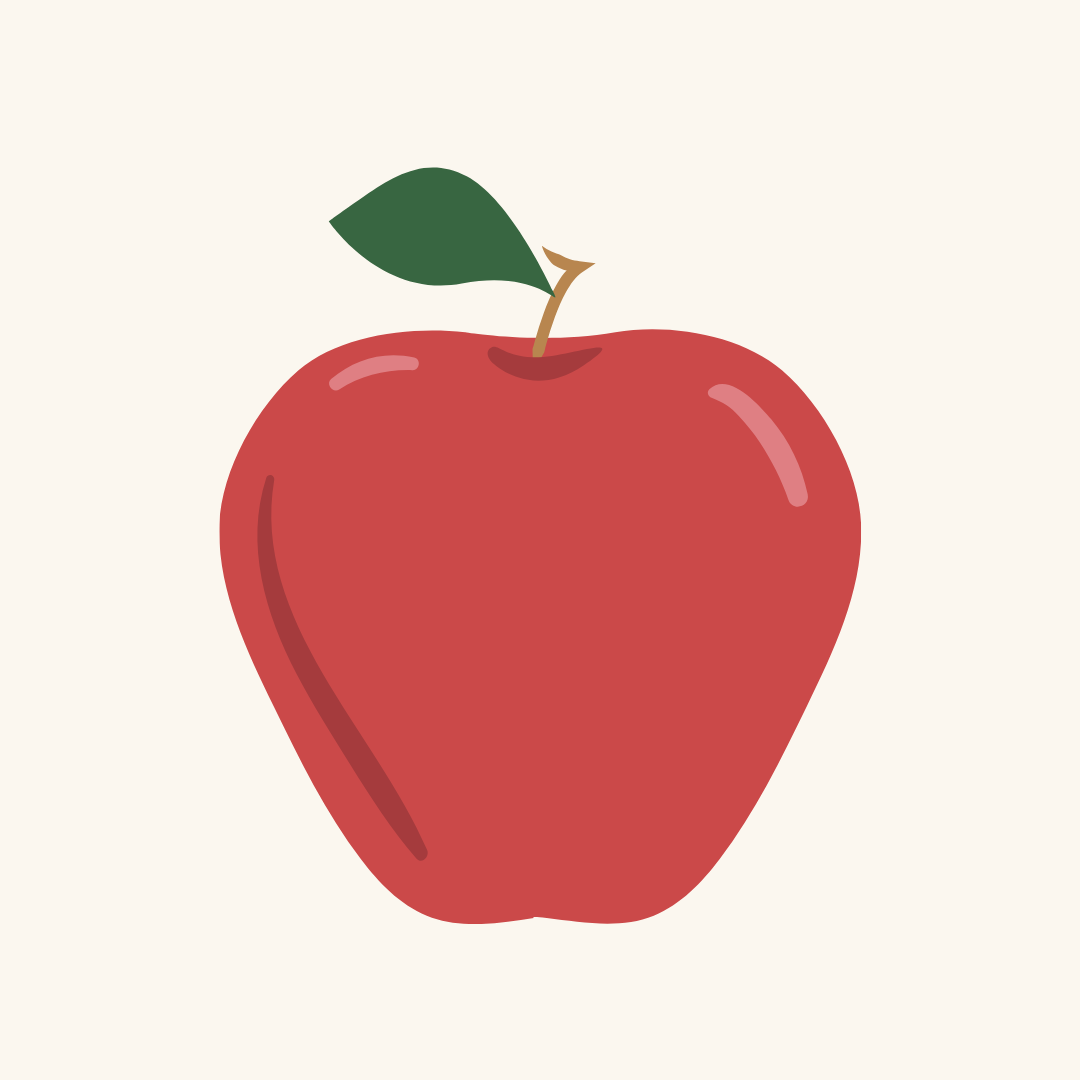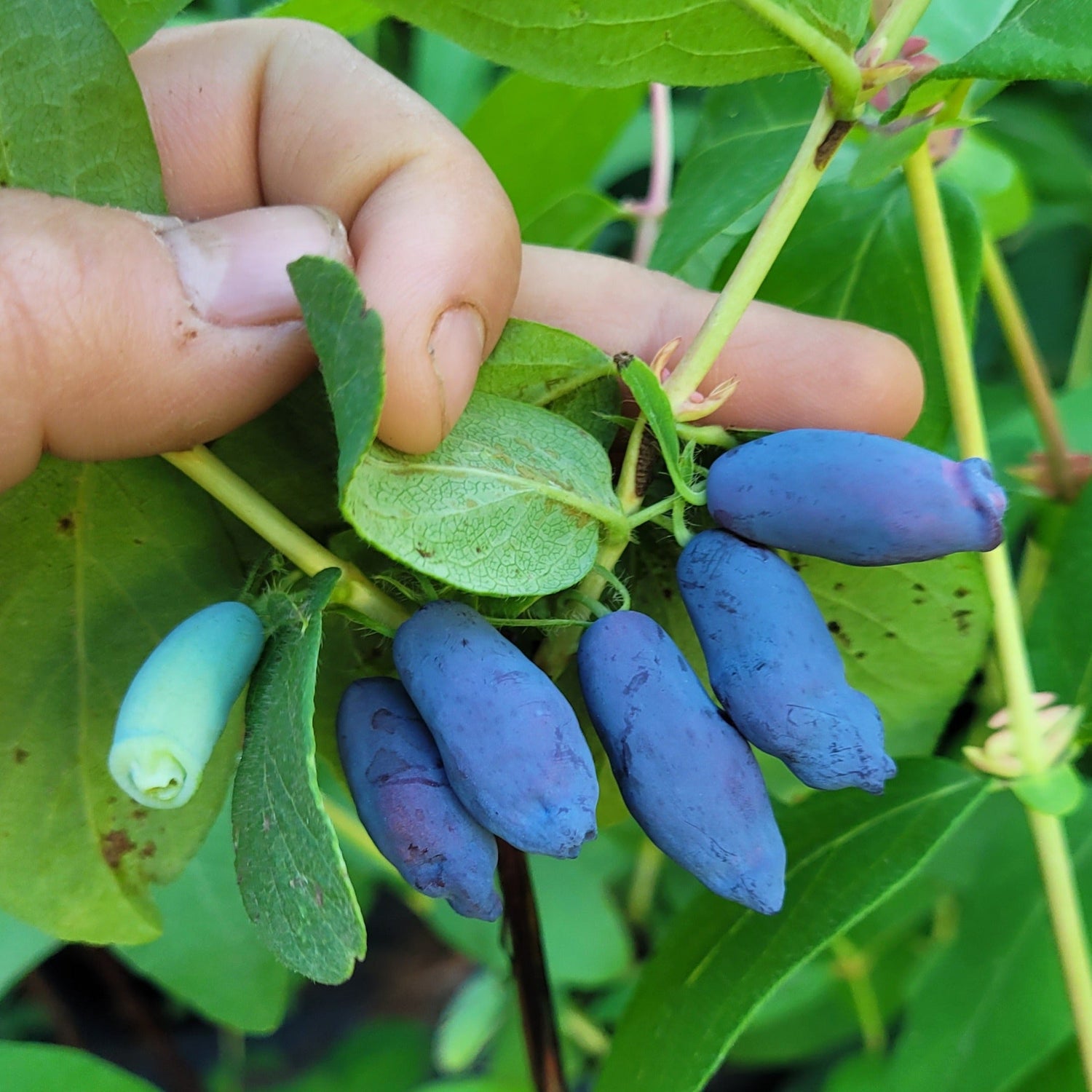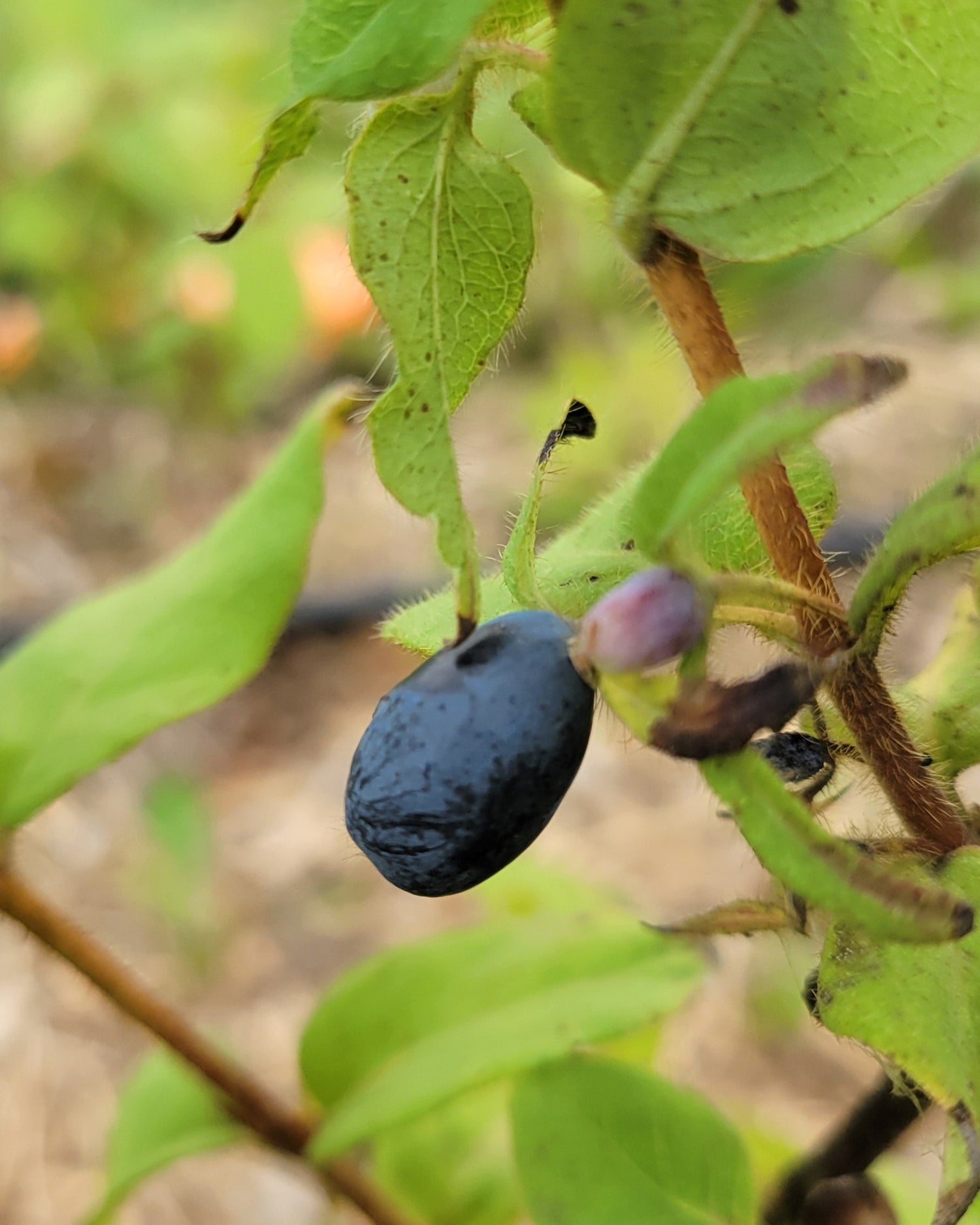All Zone 3 (or hardier) Plants
Sort by:
108 products
108 products
Species: Rubus sp
History: Hardy Black originated in Nova Scotia. As the name implies, the variety was selected for its hardiness along with excellent fruit.
Why We Grow It: This hardy variety produces large, dark berries that are sweet and juicy. To make it even better, they bear fruit over a long period of time which gives you that much more of an opportunity to enjoy these lovely berries.
Species: Cornus mas
History: Cornelian Cherry (aka Cornel) is a dogwood species native to parts of Europe and Asia. The berries were traditionally used mainly in cooking and to make jams and alcohol and have also been used in traditional Chinese medicine along with the leaves. The wood is quite dense (it sinks in water!) and has been used to make tool handles, machine parts, weapons in Ancient Greece, and the sticks traditionally carried by the mounted herdsman in the Maremma region. In the UK there was some interest in its use as a garden plant starting in the mid 1500s but interest has mainly grown in the last century or so.
Why We Grow It: A novelty among the dogwoods, Cornelian Cherries produce small, red fruits that resemble cherries. The acidic fruit can be eaten fresh when they're quite ripe but are primarily used for cooking and preserves, similar to cranberries. They are also attractive ornamental plants, producing clusters of bright yellow flowers very early in the season.
History: Whitney crabapples were grown from seed by nurseryman A.R. Whitney around 1865 at Whitney Nursery in Illinois, US. It became popular for its excellent cold hardiness and productivity and in the 1900s the state of Montana recommended it as one of the best crabapple varieties to grow.
Why We Grow It: These large (for a crabapple) yellow and red apples boast a sweet-sharp flavour with some astringency and juicy, crispy flesh. They are a truly multipurpose fruit and can be eaten fresh (if you like some astringency to your apple) or used for cooking, sauce, cider, and jelly. The trees are very cold hardy and boast good disease resistance as well.
History: Brown's Apple was discovered in Devon, UK, in the early 1900s and is considered a traditional English cider apple. It remains quite popular in the area.
Why We Grow It: This traditional variety boasts cold-hardiness and a resistance to scab. It is great for making cider thanks to being simultaneously high in both acid and sugar, an uncommon feature in most apples. Brown's Apple presses to a fragrant, vintage quality juice.
Species: Vaccinium corymbosum x V. angustifolium
History: Northblue was bred by the University of Minnesota as part of a hybrid blueberry breeding program that started in 1967. The goal of the program was to cross highbush and lowbush blueberries in order to create high-quality cold hardy varieties. Of the three varieties initially created in this program, Northblue was noted for having the largest fruit and highest productivity. Northblue was introduced to the public in 1983.
Why We Grow It: Northblue produces nicely sized, firm blueberries that store well. The berries have a good sweet flavour akin to that of wild blueberries and are great for a variety of uses. The compact shrub is quite productive and cold hardy.
Species: Vaccinium corymbosum x V. angustifolium
History: Northcountry was bred by the University of Minnesota as part of a hybrid blueberry breeding program that started in 1967. The goal of the program was to cross highbush and lowbush blueberries in order to create high-quality cold hardy varieties. Northcountry itself was created in 1968 and was introduced in 1986.
Why We Grow It: Northcountry produces small to medium blueberries with a sweet flavour akin to that of wild blueberries. For those looking to enjoy fresh blueberries as soon as possible each year, this variety is an excellent choice since it ripens quite early. The compact bush is also quite cold hardy and productive!
Species: Lonicera caerulea
History: Borealis was created by Bob Bors at the University of Saskatchewan and was released in 2007, likely being selected for its large fruit, good flavour, and resistance to powdery mildew.
Why We Grow It: Borealis produces large, round berries with an excellent flavour, albeit less sweet than more modern haskap varieties. The berries are excellent for baking although they are a bit softer and need to be handled more delicately when being picked. The bush itself is a little more compact than other varieties and is very resistant to powdery mildew.
Species: Myrica pensylvanica
History: Northern Bayberry can be found from Ontario to Newfoundland and south to North Carolina, most frequently growing along the west coast. Its berries are a food source for several birds and small mammals. The berries also produce a waxy coating that European colonists used to make candles.
Why We Grow It: This hardy, nitrogen-fixing shrub is a great addition to fencelines, native gardens, and areas that need erosion control. The berries are a good food source for several species and the crafty gardener can also use the berries to make clean-burning candles. They will spread over time.
Species: Prunus cerasus
History: These sour cherry seedlings are grown from Juliet seeds we've collected here at Silver Creek Nursery from our own trees! Juliet, is one of the members of the Romance Series released in 2004 from the University of Saskatchewan.
Why We Grow It: Seedling fruit trees are a great way to add some diversity and mystery to your garden or orchard! The parent variety, Juliet, has a sweet/tart flavour that some enjoy for fresh eating and is great for processing. A naturally dwarfing and bush-like variety. For a full description, see our Juliet page here.
Please Note: Since sour cherries tend to stay true to type more than apples, these seedlings will likely bear a strong resemblance to their parent variety. However, any specific information listed on this page should be taken with a grain of salt as there may be some variation from the parent tree.
History: Cortland apples were first bred in 1898 by Cornell University in New York and introduced in 1915. Since then, they have become one of the top fifteen apples in the US and Canada, although the majority are still grown relatively close to the university where they originated. While there are different versions of Cortland available with features such as redder skin, we are happy to offer the original!
Why We Grow It: Especially with older, popular varieties, we are always happy to offer what is, to the best of our knowledge, the original strain. Cortland is a sweet apple with crisp, juicy flesh. It is great for applesauce or drying as the flesh is slow to brown. The fruit keeps until Christmas under home storage conditions although the crispness and flavour does fade over time. This variety crops well annually and makes a good pollinator for others.
2025 Staff Favourite
Mavor Sunchokes are Zack's favourite this year! In his personal experience "the large tuber size of these sunchokes makes them a great potato substitute. They are great fried in beef tallow!”
All Staff Favourites are 20% off. The Staff Favourite Discount cannot be combined with other quantity discounts.
Species: Helianthus tuberosus, Sunchokes are also known as Jerusalem Artichokes or J Chokes
History: Mavor sunchokes are of unknown origin since they were kindly given to us by a local customer named A. Mavor. We were impressed with the large size and flavour of this variety and wanted to make them available to more customers, so are offering them under the name Mavor as thanks to the person who gave them to us.
Why We Grow It: Mavor sunchokes produce large, knobby tubers that are great for cooking in all the same ways you would cook a potato. At least in our soil, some of the tubers produce have a nice reddish tinge to the skin. The tubers store quite well in the fridge. It is a quick growing variety and, like other sunchokes, can spread quite aggressively if left unmanaged.
Species: Prunus cerasus
History: These Meteor seedlings are grown from seeds we've collected here at Silver Creek Nursery from our own trees! Meteor was introduced from the University of Minnesota in 1952.
Why We Grow It: Seedling fruit trees are a great way to add some diversity and mystery to your garden or orchard! The parent variety, Meteor, is a reliable, hardy variety that is great for pies. They naturally have a more compact growth habit. For a full description, see our Meteor page here.
Please Note: Since sour cherries tend to stay true to type more than apples, these seedlings will likely bear a strong resemblance to their parent variety. However, any specific information listed on this page should be taken with a grain of salt as there may be some variation from the parent tree.
Species: Lonicera caerulea
History: Indigo Gem was bred by Bob Bors at the University of Saskatchewan as part of the Indigo Series, a series of five varieties that all share the same parents. They were bred sometime in the mid to late 2000s and released around 2010/2011. Indigo Gem is the most productive variety of the series.
Why We Grow It: Indigo Gem produces fairly round berries that are sweeter and smaller than most haskaps, although they still have that characteristic tartness to them! It is considered one of the better options for fresh eating and like other haskaps is also great in baking, making preserves, etc.
Species: Aronia melanocarpa
History: Nero was created in Russia by plant breeder Ivan Michurin in either the late 1800s or early 1900s. Likely selected for its large fruit and sweeter flavour, Nero is still used commercially in Russia to this day.
Why We Grow It: Nero produces ample clusters of dark berries that are somewhat sweeter and less astringent than other aronia varieties, making it more favourable for fresh eating. Like other aronia berries, it is ideal for baking, cooking, jellies, etc. While the berries ripen in August, they can hang onto the bush for a couple months and tend to sweeten over time. The plant itself is tough and cold hardy.
Species: Shepherdia argentea
History: Silver Buffaloberries are native to the southern parts of the prairies, parts of the northern US with scattered populations further south. It is an important source of food and habitat for many species including Saskatchewan's provincial bird the sharp-trailed grouse. It is traditionally used by indigenous peoples in its range as food, seasoning, medicine, dyes, and in coming-of-age ceremonies for girls.
Why We Grow It: Silver Buffaloberries are an excellent addition to native gardens, food forests, and hedgerows! They are tolerant of a wide array of conditions and are also nitrogen-fixing. These shrubs are some of the first to produce flowers each spring, making them good resource for pollinators. The berries, which are often red but may be orange or yellow, are a good source of food for birds later in the season. The edible berries are on the bitter/tart side but are much more enjoyable when made into jams, jellies, and pies! Just be mindful these shrubs are thorny and will spread over time.
Species: Amelanchier x wiegandii (likely a hybrid of A. arborea and A. sanguinea)
History: There is little information on the origin of Isaac although it is believed to be a cross between the Common Serviceberry (A. arborea) and the Roundleaf Serviceberry (A. sanguinea). It was likely selected for its large, sweet berries.
Why We Grow It: Isaac produces very large berries with a lovely sweet flavour. Like other serviceberries they are great for fresh eating, cooking, baking, and preserving. Isaac makes a nice ornamental shrub with its rounded shape and white blooms in the spring. It is generally an adaptable and cold hardy plant as well!
History: Goodland was developed at the Morden Research Station in Manitoba as part of an effort to breed cold hardy apples for the prairies. It is a seedling of Patten Greening that was selected in 1925 and the variety was introduced commercially in 1955.
Why We Grow It: The cold hardy Goodland produces a medium to large yellow apple with red striping. This crisp, juicy apple has sweet/tart flavour that is great for fresh eating, cooking, and sauce. Unlike most early ripening varieties, Goodland will store well for several months.
Species: Aesculus glabra
History: Ohio Buckeye is native to Walpole Island in Ontario and some central and southern states in the United States. The Shawnee name for the tree is 'hetuck' which means 'eye of the buck' due to the nut's resemblance to a deer's eye. Indigenous peoples such as the Lenape traditionally use the nuts for medicinal uses, tanning leather, and jewellery. Ohio Buckeye is the state tree of Ohio and people from Ohio and graduates of Ohio State University are sometimes called 'buckeyes'. Unsurprisingly, the nuts have an important cultural place in Ohio. There is a candy resembling the nuts called 'buckeyes' that are popular and the nuts make numerous appearances in Calvin and Hobbes whose author is from Ohio. Its wood is too soft to be used for much and it has limited uses as a street tree since it is considered messy due to the nuts it drops.
Why We Grow It: Ohio Buckeye is an attractive ornamental tree with its large, palmate leaves and notable yellow flowers in spring. Although the tree is toxic and generally not fed on by wildlife, the large flowers are very attractive to a variety of pollinators including hummingbirds!
























